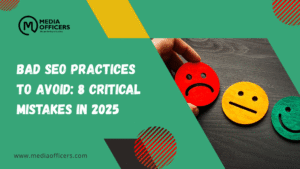Bad SEO Practices are not just harmless missteps they can actively harm your site’s visibility, credibility, and organic traffic. In this guide, we expose the eight most damaging mistakes and provide practical, ethical alternatives that align with Google’s guidelines. If you want sustainable growth, you must identify and replace these pitfalls with proven strategies.
Understanding what to avoid is the first step in building a resilient SEO strategy. This article breaks down eight concrete examples of Bad SEO Practices and pairs each with actionable, compliant replacements. By focusing on user intent, high-quality content, and technical integrity, you’ll improve both rankings and trust with your audience while staying aligned with SEO best practices.
1. Keyword Stuffing: When More Isn’t Better
Keyword stuffing is a classic bad SEO practice that saturates pages with the main target term or its variants. It hurts readability, reduces dwell time, and signals manipulation to search engines. Over time, it can trigger penalties or lowered rankings as algorithms prioritize user-friendly content over keyword-heavy copy.
What to do instead:
- Write for humans first, then optimize for search engines.
- Use the focus keyword Bad SEO Practices naturally in headings, meta, and early in the content without forcing it.
- Incorporate related terms and synonyms (LSI keywords) to cover intent breadth and context.
- Improve on-page signals with well-structured sections, clear paragraphs, and descriptive alt text for images.
2. Cloaking, Sneaky Redirects, and Deceptive Tactics
Cloaking, doorways, and deceptive redirects are unmistakable bad SEO practices that aim to present different content to search engines than to users. These tricks violate Google’s guidelines and can lead to severe penalties, including ranking drops or site deindexing.
What to do instead:
- Serve the same content to users and search engines, ensuring transparency and trust.
- Use legitimate 301 redirects when migrating pages or consolidating content; document the changes for users and search engines.
- Prioritize crawlable, indexable pages and avoid masking information behind scripts that hinder accessibility.
3. Thin Content and Duplicate Content
Thin content provides minimal value to readers, while duplicate content confuses search engines about which page to rank. Both are common bad SEO practices that waste crawl budget and dilute topical authority. Thin content often fails to answer user intent, lowering engagement and conversions.
What to do instead:
- Develop comprehensive, original content that solves real problems for your audience.
- Audit for duplicates across the site and consolidate or canonicalize pages to signal the preferred version.
- Use structured data and schema where appropriate to help search engines understand content without resorting to fluff.
4. Buying Links and Link Schemes
Bad SEO Practices around link building such as purchasing links or participating in link exchanges undermine trust and can trigger manual actions. Search engines prize earned, relevant, high-quality links, not paid shortcuts.
What to do instead:
- Focus on creating link-worthy content that earns organic coverage and citations from reputable sources.
- Engage in legitimate outreach: build relationships, guest posting on authoritative sites, and provide real value.
- Regularly audit your backlink profile and disavow toxic links that could harm rankings.
5. Over-Optimization and Exact Match Anchor Text
Over-optimizing for exact-match keywords or forcing anchor text distributions is a bad SEO practice. It can create an artificial look and raise red flags with search engines, risking penalties or diminished relevance signals.
What to do instead:
- Use natural, varied anchor text that describes the linked page’s value.
- Balance internal links to create a logical navigation that reflects user intent rather than keyword density.
- Maintain a healthy ratio of exact-match, branded, and generic anchors to preserve trust and readability.
6. Ignoring User Experience and Core Web Vitals
A site that loads slowly or delivers a poor user experience signals Bad SEO Practices to both users and search engines. Core Web Vitals such as loading speed (LCP), interactivity (FID), and visual stability (CLS) are ranking factors that reflect real user experience. Neglecting them hurts engagement and conversions.
What to do instead:
- Improve server response times, optimize images, and leverage browser caching to boost LCP.
- Reduce JavaScript blocking and optimize third-party scripts to improve FID and CLS metrics.
- Regularly audit mobile usability and ensure clean, accessible interfaces across devices.
7. Neglecting Mobile Optimization
With the majority of people browsing on mobile, ignoring mobile optimization is a costly bad SEO practice. Responsive design alone isn’t enough the mobile experience must be fast, readable, and navigable. Sites that fail mobile tests lose traffic and rankings over time.
What to do instead:
- Adopt a responsive design that adapts to all screen sizes and orientations.
- Prioritize mobile-first indexing by delivering content that loads quickly on mobile networks.
- Optimize touch targets, font sizes, and layout to reduce friction and boost engagement on mobile.
8. Auto-Generated Content and Spammy Automation
Relying on auto-generated content or mass-produced, low-quality material is a bad SEO practice that erodes trust and user value. Google emphasizes high-quality, original content that serves a real need. Automation should support, not replace, thoughtful writing and expertise.
What to do instead:
- Invest in skilled writers or editors who can produce authoritative, accurate content.
- Use automation for data gathering or structure, not for core content that users will read and share.
- Fact-check thoroughly and provide citations to credible sources to enhance credibility.
Frequently Asked Questions
What are some examples of bad SEO practices to avoid?
Examples include keyword stuffing, cloaking, thin or duplicate content, buying links, over-optimizing anchor text, ignoring Core Web Vitals, neglecting mobile usability, and relying on auto-generated content. Each has tangible risks to rankings and user trust.
How can I recover from penalties caused by bad SEO practices?
Begin with a comprehensive audit to identify violations, remove manipulative tactics, and submit a reconsideration request if manual actions occurred. Then rebuild a compliant strategy focused on quality content, ethical link building, and technical health.
What are the best practices to replace bad SEO practices?
Emphasize user-focused content, natural keyword usage with appropriate LSI terms, earned high-quality backlinks, excellent page experience, and mobile-first design. Regularly review Google guidelines and update content to maintain alignment with evolving standards.
How long does it take to see results after avoiding bad SEO practices?
Results vary by site, industry, and effort, but improvements in user engagement and technical health typically manifest within 6–12 weeks. Sustainable growth through ethical practices often yields longer-term, steady ranking gains and traffic.
Conclusion
In short, steering clear of Bad SEO Practices and adopting ethical, user-centered strategies is the fastest route to lasting visibility. By focusing on high-quality content, legitimate link building, and superior user experiences, you align with Google’s guidelines and set your site up for durable organic traffic. Remember: SEO is a marathon, not a sprint. Prioritize clarity, helpfulness, and credibility, and your rankings will follow.





